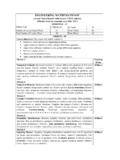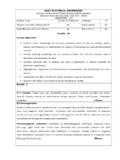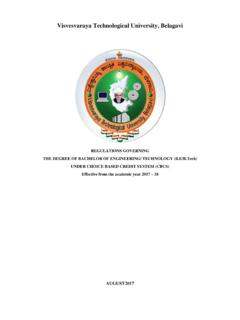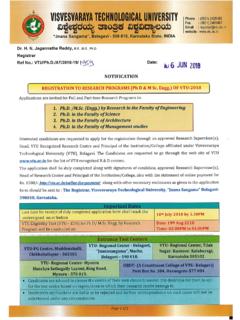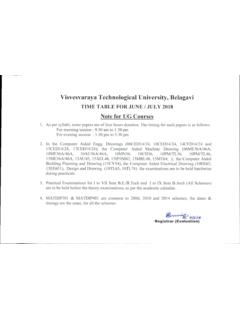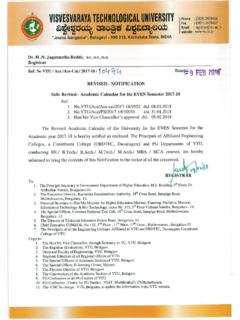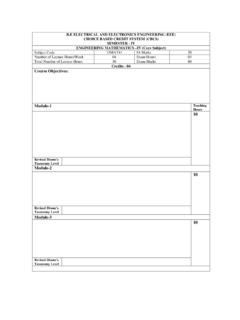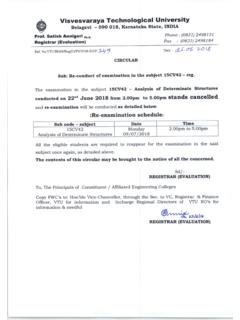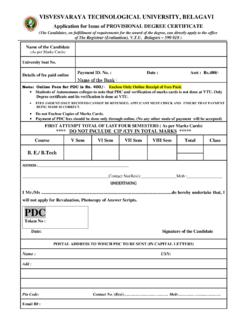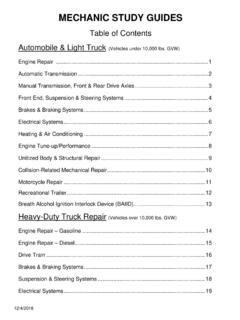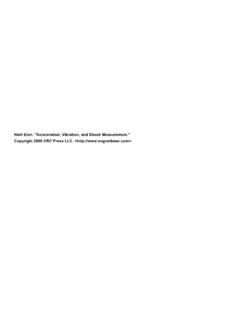Transcription of First Semester Engineering Degree Examination Subject ...
1 Subject Code- Page 01 of 03 Model Question Paper-I with effect from 2021 (CBCS Scheme) USN First Semester Engineering Degree Examination Subject Title 21 PHY12/22 TIME: 03 Hours Max. Marks: 100 Note: 01. Answer any FIVE full questions, choosing at least ONE question from each MODULE. 02. Draw neat sketches where ever necessary. 03. Constants : Speed of Light c = 3 108 ms-1,Boltzmann Constant k = 10-23 JK-1, Planck s Constant h = 10_34 Js, Acceleration due to gravity g = ms-2, Permittivity of free space 0 = 10 12 F m 1. Module -1 Marks a Define SHM and mention any two examples. Derive the differential equation using Hooke s law. 07 b With a neat diagram, explain the construction and working of Reddy s shock tube.
2 Mention the any three applications of shock waves. 09 c A free particle is executing in straight line with a period of 5 seconds after it has crossed the equilibrium point, the velocity is found to Find the displacement at the end of10 seconds ,and also the amplitude of oscillation. 04 OR a What are damped oscillations. Discuss the theory of damped oscillations. Represent overdamping, critical damping and under damping by graph. 10 b Define Mach number. Distinguish between Ultrasonic, subsonic, supersonic, and hypersonic waves. 06 c The distance between two pressure sensors in a shock tube is 200 mm. The time taken by a shock wave to travel this distance is If the velocity of sound under the same condition is 340 m/s. Find the Mach number of the shock wave, 04 Module-2 Q.
3 03 a State Wein s law and Rayleigh-Jeans law and mention their draw backs. 06 b Assuming the time independent Schrodinger s wave equation discuss the solution for a particle in one dimensional potential well of infinite height and hence obtain the normalized wave equation. 10 c A particle having mass of has a kinetic energy of 100 eV. Calculate the deBroglie wavelength, where c is the velocity of light. 04 OR a Starting from Planck s quantum theory of radiation arrive at Wein s law and Rayleigh-Jean s law. 08 b State Heisenberg uncertainty Principle. Show that electron does not exists inside the nucleus by this Principle. 07 c A quantum particle confined to one dimensional box of width a is in its First excited state. What is the probability of finding the particle over an interval of a/2 marked symmetrically at the center of the box.
4 05 Module-3 Q. 05 a Define the terms population inversion and Meta stable state. Explain the construction and working of semiconductor laser. 09 Subject Code- Page 02 of 03 b With neat diagram explain the working of Intensity based displacement sensor using optical fiber. 07 c Estimate the attenuation in an optical fiber of length 500m when a light signal of power 100mW emerges out of fiber with a power 90Mw. 04 OR Q. 06 a Derive the expression for numerical aperture of an optical fiber. Mention any two merits and demerits of optical communication. 10 b Explain how laser find application in eye surgery 05 c The ratio of population of two energy levels out of which upper one corresponds to a metastable state is 10-30 . Find the wavelength of light emitted at 330 K.
5 05 Module-4 Q. 07 a Mention any four assumptions of Drude-Lorentz model and discuss the success of Quantum free electron theory. 10 b Derive Clausius-Mossotti equation. 05 c Show that occupation probability at an energy EF+ E is equal to non-occupation probability at the energy EF- E 05 OR Q. 08 a What is hall effect . Obtain the expression for the hall coefficient 08 b Obtain expression for electrical conductivity in metals on quantum model 08 c Find the temperature at which there is 1% probability that a state with an energy eV above the fermi energy is occupied. 04 Module-5 Q. 09 a With neat diagram, explain the principle, construction and working of Atomic Force Microscope. 10 b Explain in brief how crystal size is determined by Scherrer s equation.
6 05 c Determine the wave length of X-rays for crystal size of 10-6 m, peak width is and peak position 30O, for a cubic crystal. Given Scherrer s constant k= 05 OR Q. 1 0 a Explain the construction and working of X-Ray diffractometer. 07 b With neat diagram, explain the principle, construction and working of X-ray photoelectron spectroscope. 08 c The First order Bragg reflection occurs when a monochromatic beam of X-rays of wavelength is incident on a crystal at a glancing angle of 4o. What is the glancing angle for third order Bragg s reflection to occur? 05 Table showing the Bloom s Taxonomy Level, Course Outcome and Program Outcome Question Bloom s Taxonomy Level attached Course Outcome Program Outcome (a) L1 PO-1,2,12 (b) L2 ,12 (c) L3 PO-1 (a) L3 PO-1,2,12 (b) L2 PO1, (c) L3 PO-1 (a) L2 PO-1,2,12 (b) L3 PO-1,2,12 (c) L3 PO-1 (a) L2 PO-1,2,12 (b) L3 PO1,2,12 (c) L3 PO-1 Subject Code- Page 03 of 03 (a) L1 PO-1,2,12 (b) L2 PO-1,2,12 (c) L3 PO-1 (a) L2 PO1,2,12 (b) L2 PO-1,2,12 (c) L3 PO-1 (a) L2 PO-1,2,12 (b) L3 PO-1,2,12 (c) L3 PO-1 (a) L1 PO-1,2,12 (b) L2 PO-1,2,12 (c) L3 PO-1 (a) L2 PO-1,2,12 (b) L3 PO-1,2,12 (c) L3 PO-1 (a) L2 PO-1,2,12 (b) L2 PO-1,2,12 (c)
7 L3 PO-1 Bloom s Taxonomy Levels Lower order thinking skills Remembering( knowledge): 1 Understanding Comprehension): 2 Applying (Application): 3 Higher order thinking skills Analyzing (Analysis): 4 Valuating (Evaluation): 5 Creating (Synthesis): 6
